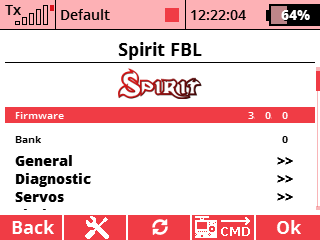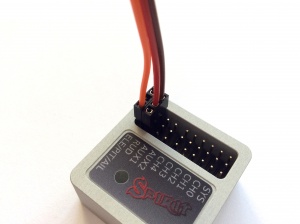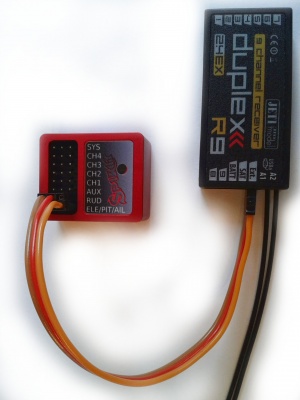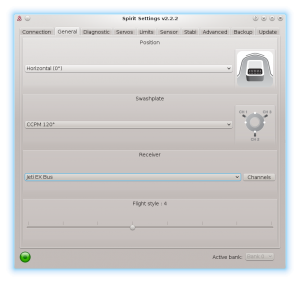Intégration JETI
A partir de la version 1.1.0 vous pouvez utiliser l'intégration JETI! Ce qui veux dire que vous pouvez modifier toutes les options de configuration avec un transmetteur JETI en temps réel sans l'utilisation d'un ordinateur
Contents
1 Exigences
Pour faire fonctionner le tout vous aurez besoin de:
- Transmetteur Jeti Duplex: DS/DS 14 or 16 or 24
- Receveur Jeti Duplex avec un port "EX" de libre.
- Le câble d'intégration Jeti est disponible dans la boutique en ligne de Spirit.
- Fichier de configuration pour le transmetteur.
2 Câblage
Le receveur est capable de transférer n'importe quelle donnée incluant les données des canaux et la télémétrie. Ce qui veux dire que vous n'avez besoin de connecter aucun autre câble ou module a l'exception du receveur
Le cable des servo doit etre connecté a un port EX Bus sur le receveur.
- Pour les nouveaux receveur vous devez connecter sur le port "E1" ou "E2" car le port EXT ne fonctionnera pas
- Pour les receveurs plus vieux le port a utiliser est toujours "EXT".
If you are using EX receivers with attached telemetry sensor to the EXT port in this case you have two options:
- To use UDI connection (SRXL/SUMD receiver type) - in this case you will loose the Jeti Integration.
- To buy a REX receiver where you can use a telemetry sensors and the Jeti integration together.
3 Préparation du transmetteur
Maintenant télécharger Fichier de configuration, c'est un fichier portant l'Extention .BIN . Le nom du fichier est "Spirit.bin". Ce fichier doit être copier dans le répertoire "Devices" situé sur votre carte SD qui est installé dans votre transmetteur. Si vous ne copiez pas ce fichier dans le bon répertoire vous allez recevoir un message d'erreur a l'ouverture du Spirit.
You can copy it by connecting the micro USB cable to the transmitter similarly as to an USB flash drive. When cable is attached to the transmitter you have to confirm the USB connection. Then simply drag and drop it to the Devices directory as you are used to.
It is very important to use the same version of the BIN file as your current firmware in the unit. If the versions are not matching then an incompatibility issues could occur.
4 Configuration du Spirit
Maintenant vous êtes prêt a allumer l'unité. Si votre source d'alimentation n'est pas encore connecté Spirit recommande de la connecter dans un des ports suivant AUX,AUX2 ou CH0. Vous pouvez utiliser la connexion d'intégration JETI. C'est important de bien choisir l'option "EX" dans la table général du programme fourni par Spirit. Svp démarrer le logiciel de configuration du Spirit et changer le type de receveur tel qu'illustré sur la photo. Ensuite enregistré les modifications (ex: raccourci clavier pesez "CTRL+S") ou aller dans l'onglet "Backup tab/Unit" et enregistrer. Ne pas oublier de redémarrer l'unité Spirit.
5 Menu intégration
When unit is initialized you are able to enter the Jeti Integration menu. Press the MENU button on the transmitter.
Then select the Model menu by a rotary knob.
And then enter the Device Explorer menu.
There, if the wiring and receiver type is correct, you will see the Spirit entry.
5.1 Stil can't see the Spirit?
If you have everything right, but the unit is still not visible, then the only problem can be that the EX Bus port of your receiver is configured to a different protocol.
In this case, enter the configuration menu of your receiver in the Device Explorer - the entry has name of your receiver. Change the Serial Link to the EX Bus. In case of the REX receivers you can assign E1 or E2 port to EX Bus in the Alternative Pin Config menu.
6 Usage
Whenever you want to configure a parameter, go to the Model/Device Explorer/Spirit. There the Menu Layout is nearly identical with the PC software to have easy navigation.
It is working in the same way as when the PC software is connected. This mean that when Jeti Integration menu is opened, you can change even the basic parameters that could affect the helicopter significantly.
When using the Bank Switching or Real-Time tuning features the menu will take full control of it. The unit will not react to a Switch position changes. For the Bank Switching there is a menu Bank Switching where you can manually change the banks.
Do not forget to click the Save Settings when you want to save a changes permanently.
7 Preset for transmitter
You can use our preconfigured profile for the transmitter where everything should be configured to be ready to fly.
The profile has enabled:
- Flight modes
- Bank Switching
- Rescue/Stabilisation modes (activated by a Separate channel)
You can download it right here (Optimized for Jeti DS-14). Then unzip the file and save the JSN file to your transmitter (SDCard) to the Model directory.
In your transmitter there will be new profile called Spirit FBL that you can select.
Enjoy the integration!
8 Channel Mapping
In case that your channels are not matching, we recommend to leave default channel mapping in the unit and to change it in your transmitter.
You can do so in the Model - Servo Assignment menu.
Channel Layout:
- Throttle
- Aileron
- Elevator
- Pitch
- Rudder
- Gyro sens.
- Bank (if used)
- Stabi (if used)
9 Données de télémétrie
In order to display Telemetry data you have to scan for new sensors first. Go to Menu - Timers/Sensors - Sensors/Logging Setup and then press AUTO button. Scanning will take a few seconds untill all Telemetry variables will show up.
- S Vibes [%] - Vibration level from all axes (0 - 10% is normal level)
- S RPM [Head RPM] - RPM provided by RPM sensor.
- S Voltage [V] - Télémétrie ESC | Voltage de la batterie
- S Current [A] - Télémétrie ESC | Ampérage de la pile
- S Capacity [mAh] - Télémétrie ESC | Main Battery consumed capacity
- S Temp [°C] - Télémétrie ESC | Température FET
Once scanning is finished you can add these variables onto the main screen. Go to Menu - Timers/Sensors - Displayed Telemetry and press the ADD button. Add all Telemetry data you want to display.









